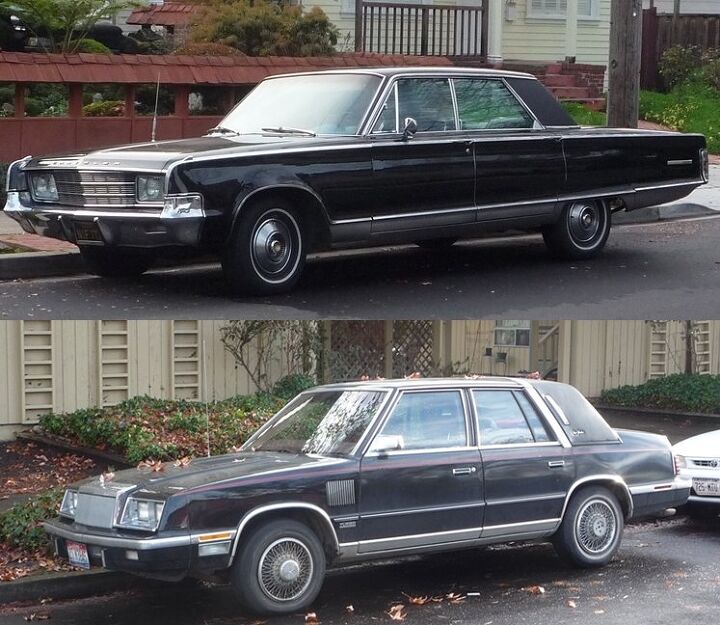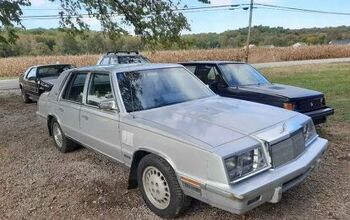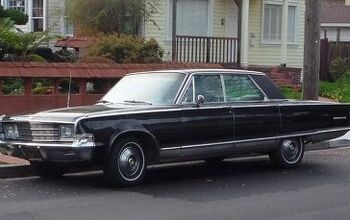Curbside Classic: 1985 Chrysler New Yorker

Let’s hold our nose and consider the decline and fall of the Chrysler New Yorker. Twenty years earlier, that name typified the grace, comfort, style and performance that New Yorkers had been know for since the first New Yorker ran off the lines in 1939. The energy crisis and the decline of the big car brought on a prolonged slide that should have ended with its retirement in 1982. But Lee Iaccoca would have none of that: the New Yorker would be reinKarnated! Add three inches to that infinitely malleable K-car platform, and slap on a healthy dollop of all the usual faux-luxury car trappings of the time, and presto: a mini-me New Yorker. Just in case you forgot what it looked like in its prime, here’s the before and after:
But don’t think just because you were getting a four-cylinder Reliant with a couple of hundred dollars worth of plasticky body add-ons bought in bulk from J C Whitney and a turbo conversion with all the subtlety and refinement of a home-brew job, that the new New Yorker was going to be a bargain. Inflation adjusted, both of these cars cost about the same: $27k in today’s dollars.
Chrysler hadn’t yet invented a V6 engine, so slapping a turbo on the 2.2 liter four was the only game in the big apple’s attempt to invoke luxury car performance. That is, if you were willing to shell out the extra bucks for it, because Lee had no compunction about the New Yorker having a 101 hp four as the standard engine. Your investment in turbo lag worthy of a stubborn mule yielded a magnificent 146 hp, once it spooled up. The little turbo four might have been some fun in the Omni GLH with a stick, but in the New Yorker teamed up with a three-speed automatic it was about as sporty as when the same combination was put to work powering a long-wheelbase Grand Caravan.
But once ensconced in that luxurious interior of fine Corinthian leather, all was well with the world. The instant response and torque of a healthy 413 V8 was now just a distant memory. Press on that go pedal, and eventually something happened, in herky jerky fashion. But it was all worth it, to save gas. Ironically, gas prices were already plummeting by the time the New Yorker hit the streets in 1983. But there was always the Fifth Avenue, a former Dodge Aspen also given the full Iacocca treatment. Its 318 V8 had less horsepower (140) but some vestige of low-end torque.
Some of the finer examples of what your $14k bought you in 1985: wire wheel covers, fake fender vents and a turbo badge. We’ll have to go to the next picture to show you the hood vents, the true mark of a refined luxury car.
There they are! The package is complete. Your New Yorker awaits you, sir!
I’ve been getting a bit tired of the endless “these all rusted out in three years” comments to Curbside Classics, and my inner Kraut is on the verge of going all Bertel and banning anyone who ever does that again :), but I’m going to postpone it for this car. So help yourself, and pile on with all the rusty comments you want, because it would make me happy to know that some parts of the country aren’t plagued with these things.

More by Paul Niedermeyer
Latest Car Reviews
Read moreLatest Product Reviews
Read moreRecent Comments
- Honda1 Unions were needed back in the early days, not needed know. There are plenty of rules and regulations and government agencies that keep companies in line. It's just a money grad and nothing more. Fain is a punk!
- 1995 SC If the necessary number of employees vote to unionize then yes, they should be unionized. That's how it works.
- Sobhuza Trooper That Dave Thomas fella sounds like the kind of twit who is oh-so-quick to tell us how easy and fun the bus is for any and all of your personal transportation needs. The time to get to and from the bus stop is never a concern. The time waiting for the bus is never a concern. The time waiting for a connection (if there is one) is never a concern. The weather is never a concern. Whatever you might be carrying or intend to purchase is never a concern. Nope, Boo Cars! Yeah Buses! Buses rule!Needless to say, these twits don't actual take the damn bus.
- MaintenanceCosts Nobody here seems to acknowledge that there are multiple use cases for cars.Some people spend all their time driving all over the country and need every mile and minute of time savings. ICE cars are better for them right now.Some people only drive locally and fly when they travel. For them, there's probably a range number that works, and they don't really need more. For the uses for which we use our EV, that would be around 150 miles. The other thing about a low range requirement is it can make 120V charging viable. If you don't drive more than an average of about 40 miles/day, you can probably get enough electrons through a wall outlet. We spent over two years charging our Bolt only through 120V, while our house was getting rebuilt, and never had an issue.Those are extremes. There are all sorts of use cases in between, which probably represent the majority of drivers. For some users, what's needed is more range. But I think for most users, what's needed is better charging. Retrofit apartment garages like Tim's with 240V outlets at every spot. Install more L3 chargers in supermarket parking lots and alongside gas stations. Make chargers that work like Tesla Superchargers as ubiquitous as gas stations, and EV charging will not be an issue for most users.
- MaintenanceCosts I don't have an opinion on whether any one plant unionizing is the right answer, but the employees sure need to have the right to organize. Unions or the credible threat of unionization are the only thing, history has proven, that can keep employers honest. Without it, we've seen over and over, the employers have complete power over the workers and feel free to exploit the workers however they see fit. (And don't tell me "oh, the workers can just leave" - in an oligopolistic industry, working conditions quickly converge, and there's not another employer right around the corner.)




































Comments
Join the conversation
I have a 1985 Chrysler New Yorker. has been doing ok till recently. Mechanic tells me it would cost more to fix then it is worth. Then I see a guy selling his for $6000. But it is all I have so if anyone can give me pointers that would be great.
Growing up, we always had multiple cars - at least 4, not including the van. My Dad always had to have a van and a sports car, and he's had some weird ones over the years. Not many people had ever heard of Saab's Sonett, but he had three of them; two which ran and one that needed work. But the first car I started to learn to drive was the 84 New Yorker he'd bought new (traded in an 83 Reliant K for it) and it was one of those talking cars, the door is ajar, etc. Anyway, it was a nice car; had the velour interior rather than leather, digital dash - I'm not sure if it was a turbo or not, but I don't think it was. Despite the low HP numbers it could get up - or at least it felt that way to a brand new permit-holder. Just seeing pics of the New Yorker brought back some good memories. Thanks for sharing.